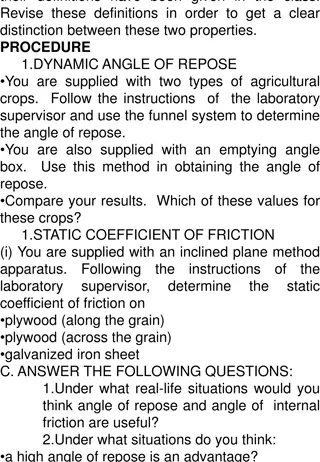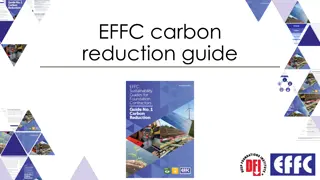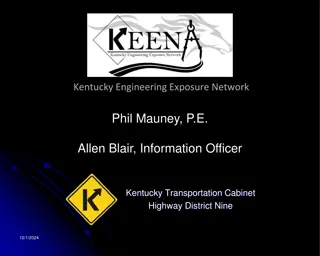Introduction to Flood Risk Assessment with HEC-FDA Overview
This presentation delves into flood risk assessment using HEC-FDA software, covering topics such as defining flood risk, components of uncertainty, consequences of flood risk, and methods to assess flood risk including hydrology, hydraulics, geotechnical, and economics. It explores the intersection
6 views • 39 slides
Understanding Soil Phase Relationships and Properties
Soil consists of solids, liquids, and gases with voids in between. Water content, void ratio, porosity, specific gravity, mass specific gravity, degree of saturation, and unit weight are key parameters in characterizing soil behavior. Relationships between these properties are crucial for geotechnic
3 views • 8 slides
Laboratory Experiments on Geotechnical Properties
This instructional guide outlines laboratory procedures for determining geotechnical properties such as dynamic angle of repose, static coefficient of friction, surface area of fruits, and screening for ground feed classification. It includes steps, apparatus required, calculations, and questions to
0 views • 4 slides
Enhancing Geotechnical Investigation Methods in Ghana for Foundation Design of Large Structures
Enhancing the standard of geotechnical investigation field testing in Ghana is crucial to ensure appropriate use of equipment like DCP for designing foundations of large structures. Objectives include assessing site suitability, obtaining design inputs, anticipating construction challenges, and esti
0 views • 31 slides
Understanding Soil Behavior and Formation in Civil and Environmental Engineering
Civil and environmental engineering heavily rely on the properties and behavior of soil and rock materials for successful project outcomes. Geotechnical engineering and environmental considerations play crucial roles in dealing with earth materials. This content explores the elemental compositions o
3 views • 18 slides
Understanding Wedge Failures in Geotechnical Engineering
Wedge failures in geotechnical engineering occur when slopes with discontinuities experience sliding along the line of intersection of two planes. This type of failure can happen under various geological and geometric conditions and involves specific criteria such as the dip of the intersecting plan
0 views • 13 slides
Structural Analysis and Design for Signal and Lighting Systems
Florence Hutcheson Lee Sewell, PE, SE conducted an in-depth structural analysis known as SALSA to examine wire span, mast arm, and high mast structures. This comprehensive study, initiated in 2007, aimed to enhance the geotechnical evaluations of pole bases to meet current standards. Through innovat
2 views • 18 slides
Louisiana Environmental Laboratory Accreditation Program (LELAP) Overview
The Louisiana Environmental Laboratory Accreditation Program (LELAP) ensures the accreditation of laboratories, stack testers, and geotechnical soil testers distinct from permittees or the Department. Accreditation is required for facilities submitting chemical analyses or data, as defined by regula
1 views • 31 slides
Innovations in Geotechnical Solutions: Enhancing Standards for Technical Textiles
Geotechnical expert Shahrokh Bagli discusses the importance of standardization for geosynthetics in India, highlighting the need for new products and innovations. Emphasizing the role of user ministries and applications, the conclave addresses the scope for standardization and the requirements of th
0 views • 9 slides
Understanding Cut Slope Design and Topographic Surveying
Geotechnical engineers and engineering geologists play crucial roles in designing earth structures based on geological data. This involves assessing and forecasting hazards, making slope design recommendations, and more. The process includes topographic surveys, rock mass characterization, photogram
0 views • 11 slides
Sustainable Construction Initiatives in Europe: A Roadmap to Carbon Reduction
European Federation of Foundation Contractors (EFFC) and Deep Foundations Institute (DFI) are leading the way in promoting sustainable practices within the construction industry. Through collaborative efforts, these organizations aim to reduce carbon emissions and establish sustainable development g
0 views • 24 slides
Modular Construction of Minor Bridges: A Detailed Process Overview
This schema outlines the steps involved in the modular construction of minor bridges, from geotechnical analysis to finalizing the bridge design. It provides insights into the process, application details, and how it works, targeting designers, constructors, onsite engineers, and design approving au
0 views • 13 slides
Explore the World of Engineering with Kentucky Engineering Exposure Network
Delve into the diverse field of engineering with the Kentucky Engineering Exposure Network (KEEN). Discover the various types of engineering specialties, the role of engineers in society, and the steps to pursue a career in this dynamic profession. Get insights into civil, structural, geotechnical,
0 views • 52 slides
Geophysics Field Testing Workshop: Methods and Interpretation
South Carolina DOT Training Workshop on geophysics field testing methods, data reduction, and interpretation of results by Robert C. Bachus and Glenn J. Rix. The workshop covers suspension logging, borehole geophysical logging, geotechnical testing, and geophysical service companies such as Schlumbe
0 views • 11 slides
Essential Aspects of Site Investigation in Civil Engineering
Civil engineering site investigations play a crucial role in determining foundation types, construction methods, and overall project costs. This process involves gathering essential information to design foundations, assess load capacities, make settlement predictions, identify groundwater levels, a
0 views • 28 slides














